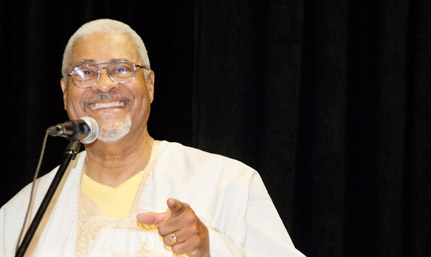 |
Africans are of blood and of soil, says Prof Charles Dumas in his inaugural lecture at the UFS. Speaking on the topic I, too, am an African, Prof Dumas reminisced about his life and experiences on the continent.
Photo: Minette Grove
05 March 2013 |
Lecture (pdf)
What is an African? Is it those born in Africa, defined in racial and genealogical terms, or those who identifies with the continent in nationality and ancestral location? Did the descendants of enslaved Africans in the US, the Caribbean or Brazil lose their Africaness when their ancestors were put on slave ships to the New World?
These were some of the questions raised by Prof Charles Dumas, visiting senior professor in the Department Drama and Theatre Arts, in his inaugural lecture at the university.
Proclaiming attachment to the continent, Prof Dumas told his audience there are two types of Africans: Africans of the blood and Africans of the soil. In a speech titled, “I, too, am an African,” he stated that he lay claim to his ancestral birthright not because of blood relationship to an identifiable ethnic group or birthright to the continent, but because he earned it.
“I suggest another way that one can be an African, is through trial and struggle to be reborn an African in spirit. It is a ritual journey that may be taken by anyone. For, after all, if we are to believe the anthropologists who tell us that human life as we know it began in the Olduvai Gorge, genetically we are all African in origin.”
Prof Dumas, a senior professor at Penn State University in the USA, took the audience on a journey of his experiences on the continent, starting in 1978 when he first came to South Africa as a legal observer. Noticing the changes between Apartheid and today’s South Africa, he said this generation are committed to learn from each other – and that is the most important, he said.
“With their hopes and aspirations they earnestly desire to live in the new South Africa that we promised them. We must support them in their effort. It is time we stored our old baggage in the closet.”